This morning I called around to the folks who run the film departments in the local high-schools and colleges and set up dates to speak with the students about the Josiah Fest.
Around noon I managed to talk myself into going out to buy a little digital still camera. My sister provided me with a windfall via a book she sold over the internet. 160 sounded like the perfect price for a cheapie camera, some batteries, and an SD card. I was right. I’m now the proud owner of a Nikon Coolpix. I guess I could have used it to pay my electric bill, but fuck it.
The camera’s damn tiny. I figured out the menus quick enough. It’s a basic point and shoot. But it has several white balance presets, a macro close-up setting, flash over-ride, and an ability to force the exposure over or under.
Now I can clutter up this blog with pictures.
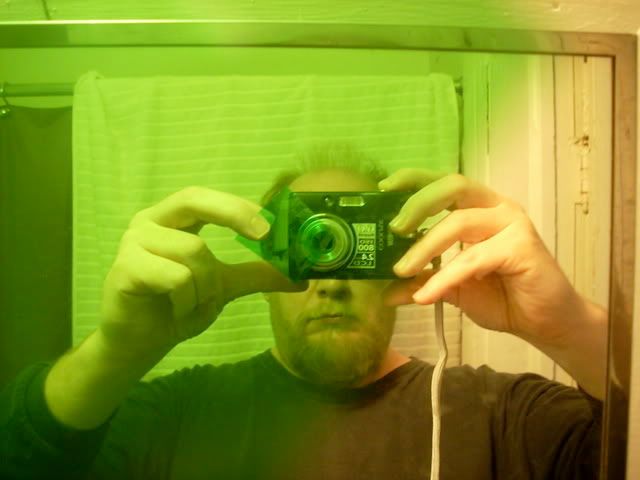
Like this, my new camera. I believe this is the first photo everyone does with a new camera. “This is me photographing myself in a mirror.” So ubiquitous do I imagine this to be, that I think camera manufacturers should just go ahead and load up every camera, at the factory, with a generic blurry photo of some person holding a camera and facing a mirror.
It was a perfect day — maybe a bit humid with the recent rains — but the sky was clear and the wind not too fierce. I decided to hop on the bike and ride out to Mission Espada and back.
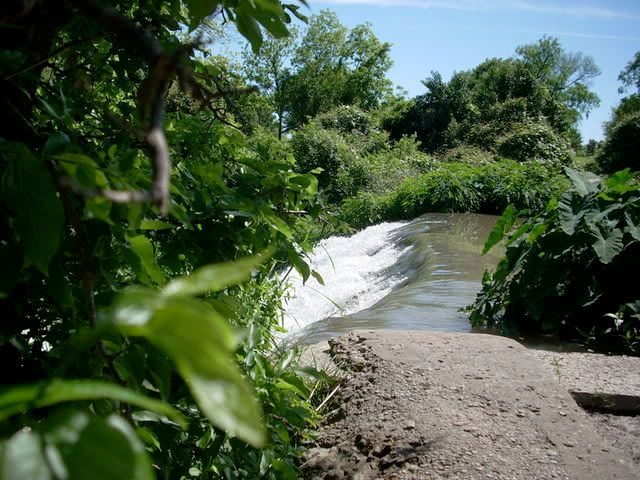
Here is the old Espada Dam, which was constructed around 1745 to divert irrigation water for the fields around the missions. At this point, the irrigation channel is running between the fence line of the Mission Burial Park (one of the older and grander cemeteries in San Antonio), and the San Antonio River. It’s always lush and green here where the water cascades over the dam, but spring is when it gets truly tropical.
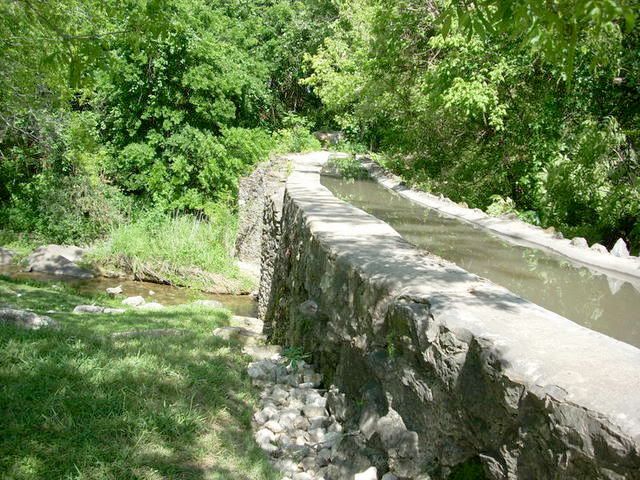
In the same area, a bit further south, is the Espada Aqueduct. It’s from the same period, and carries water over Piedras Creek. The park is usually empty, peaceful, and it’s filled with shade trees. There’s a misshapened pecan tree which grows parallel to the ground for about ten feet before going up. It’s low enough to lounge on. Many times I’ve been stretched out on it, my shoulders supported at the bend where the tree goes up, and I’ve watched car after car roll into the parking-lot, stop at the historical marker sign long enough for those inside to read it — and off they drive. They’re missing a lot.
If you eschew the bike trail, and head out of the Aqueduct park on Espada Road, you’ll go through a peaceful farming community that no doubt has it roots all the way back to the indians who built the missions. And then the bucolic idyllicness is mangled by the scar of I-410 cutting a frenetic path to the horizons, both east and west.
On the south side of the overpass is a dead-end street leading to a small cemetery. I’d been down that road before, but never with a camera. The local families who have their ancestors interred here have placed a fairly tall fence around the place. The gates are kept locked. Still, it’s a nice road to go down and explore. The whole place is canopied by large trees.
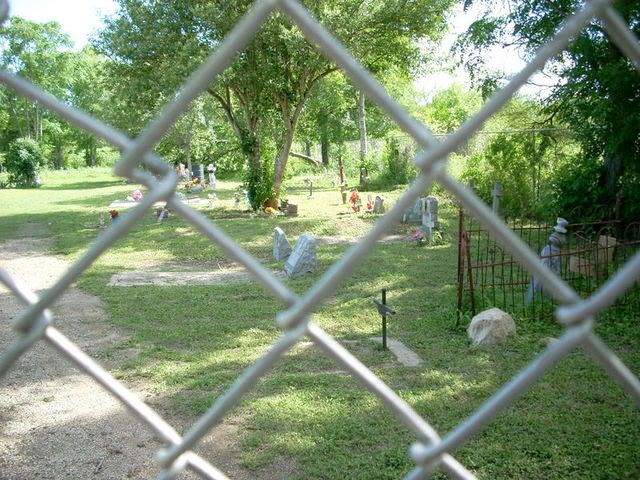
Just a bend in the road beyond the turn off to the cemetery is Mission Espada. It’s my favorite of the missions. Smallest, and in a sense, the most crudely designed. But it’s a work of art. The interior of the sanctuary vibrates with a warm intimacy. Because it’s the last Mission out from San Antonio, it’s the least visited. That’s nice, in a way, because there are never any crowds. But the downside is that fewer people get to appreciate the place.
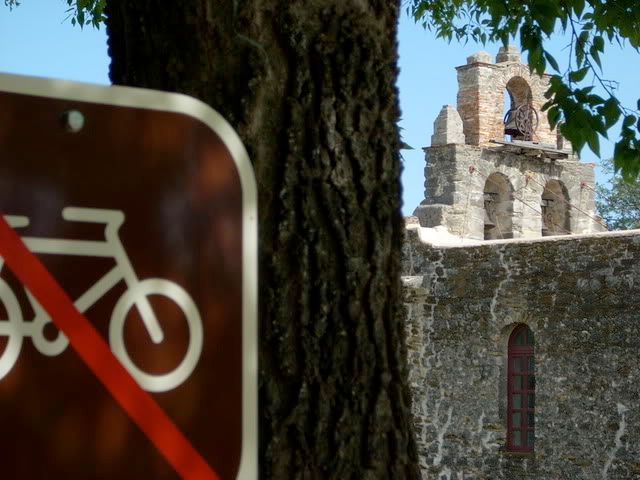
If you head further south, the road curves around and crosses the San Antonio river. This kilometer or so length of road is the Camino Coahuilteca, named for the indigenous people whose labor built the missions and worked the fields for the Spanish. I wonder how much politicking it took the Tap Pilam Coahuiltecan Nation to get those street signs up. Sounds like a nice small documentary.
@@@@@@@@@@@@@@
Fiesta (San Antonio’s two week city-wide booze-up) is drawing to a close. But the fact is, this final weekend is what people have really been holding back for. For some, it’s when they really let wail on their livers. For others (like Nikki Y-) it’s when they can indulge in a gordita (maybe 2!) with no sense of shame. [For the uninitiated, a gordita is masa dough — the same stuff you use to make corn tortillas — formed into a patty and fried. Most likely in lard. It’s split open along its perimeter like a pita bread … an artery-clogging pita bread. And it’s stuffed with savory goodies. And if you’re lucky, those goodies too have been fried. Throw on some grated cheese, and you’re in business. Salsa is optional, sissy boy. Make no mistake, a well constructed gordita can rock your world.]
But I digress.
In my neighborhood, the big Fiesta event is the King William Parade. That is followed by the King William Street Fair. I live in the King William neighborhood of San Antonio. It’s become very prestigious, with very beautiful mansions dating back to the 1880s or earlier. I live on the south side of South Alamo Street. The houses are not so grand (such as my hovel), but for some reason we have been pulled into the fold (I blame realtors … I always blame realtors).
The parade comes right down my street. And for some reason I thought the parade was Sunday. But this is what I saw on my street when I came back from my bike ride.
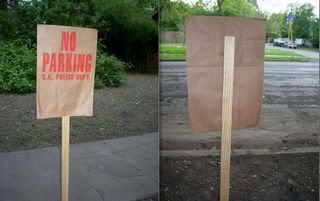
I shot both sides of the sign. They’ve been designed like this for the three years (or has it been four?) in which I’ve lived here. The signs, if you haven’t noticed, are printed on paper bags. Maybe they do this so that when they clean the streets at the end, the broom-pushers can just snatch a paper bag off a stick and start stuffing it.
I got online and discovered that the parade and street fair are Saturday. That still works for me.
For those local folks who read this and are dithering as to attending the shindiggery in King William this Saturday — just do it. The parade is great fun. And this is coming from a confirmed parade bigot (my disgust for parades is on par with my hatred of sports and musical theater). And the street fair is surreal. I just wander the streets on the other side of South Alamo Street watching people who are … watching people. It’s an insane crush of humanity, but there’s this great warm vibe.
Parking is a bitch. But if you come down as early as seven or eight in the morning (the parade officially begins at nine) I might be so kind as to let you park in my driveway. I can cr
am quite a few cars in there now that Matt has moved out of his apartment.
I’m at 716 E. Guenther
Call me at 210.482.0273.
Be prepared to bring breakfast tacos, mimosas, and lawn chairs.
@@@@@@@@@@@
After my bike ride, I enjoyed a feast of Pik-Nik 50 cent tacos and a a couple of tumblers of aguas frescas. And then I walked down to the river, two blocks from my house. I wanted to photograph (with my new camera) the wildflowers growing in profusion along the banks.
Later, after looking at the shots, I wasn’t too happy with the lighting (which I had thought would be low enough to be beautiful — I was wrong). But I quite like this view looking up at one of the more beautiful houses in my neighborhood. The picture might not do justice to the house, but I love how the sunflower is rising from the chaos of vegetation — those raw, ragged, undifferentiated weeds.
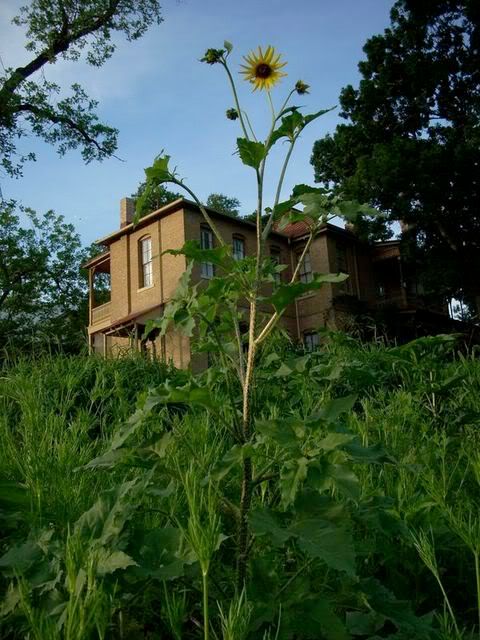
I’m fascinated by these profuse riots of weeds which grow tall and unsupervised. It’s not the inviting garden of picnics and badminton. These are the areas grown wild with stinging nettles, poison oak and sumac; where famished ticks and chiggers clutch desperately to blades of grass awaiting some warm blooded creature to fumble passed.
Weed-choked gardens are flawlessly defined in literature by both Thomas Hardy and H. P. Lovecraft. These authors really have nothing in common, other than their ability to know how crazed an untended garden can get in the height of spring.
I dig it.